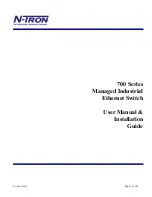
3Com Switch 8800 Configuration Guide
Chapter 23 IP Multicast Overview
23-3
Server
Multicast
User A
User B
User D
User E
User C
Server
Multicast
User A
User B
User D
User E
User C
Figure 23-3
Data transmission in multicast mode
Suppose the Users B, D, and E need the information, they need to be organized into a
receiver group to ensure that the information can reach them smoothly. The routers on
the network duplicate and forward the information according to the distribution of these
users in the group. Finally, the information is transmitted to the intended receivers B,D
and E properly and correctly.
In multicast mode, the information sender is called the "multicast source", the receiver
is called the "multicast group", and the routers for multicast information transmission
are called "multicast routers". Members of a multicast group can scatter around the
network; the multicast group therefore has no geographical limitation. It should be
noted that a multicast source does not necessarily belong to a multicast group. It sends
data to multicast groups but is not necessarily a receiver. Multiple sources can send
packets to a multicast group simultaneously.
II. Advantages
The main advantages of multicast are:
z
Enhanced efficiency: It reduces network traffic and relieves server and CPU of
loads.
z
Optimized performance: It eliminates traffic redundancy.
z
Distributed application: It enables multipoint application.
23.1.3 Application of Multicast
IP multicast technology effectively implements point to multi-point forwarding with high
speed, as saves network bandwidth a lot and can relieve network loads. It facilitates
also the development of new value-added services in the Internet information service
area that include online live show, Web TV, tele-education, telemedicine, network radio
station and real-time audio/video conferencing. It takes a positive role in:
z
Multimedia and streaming media application















































